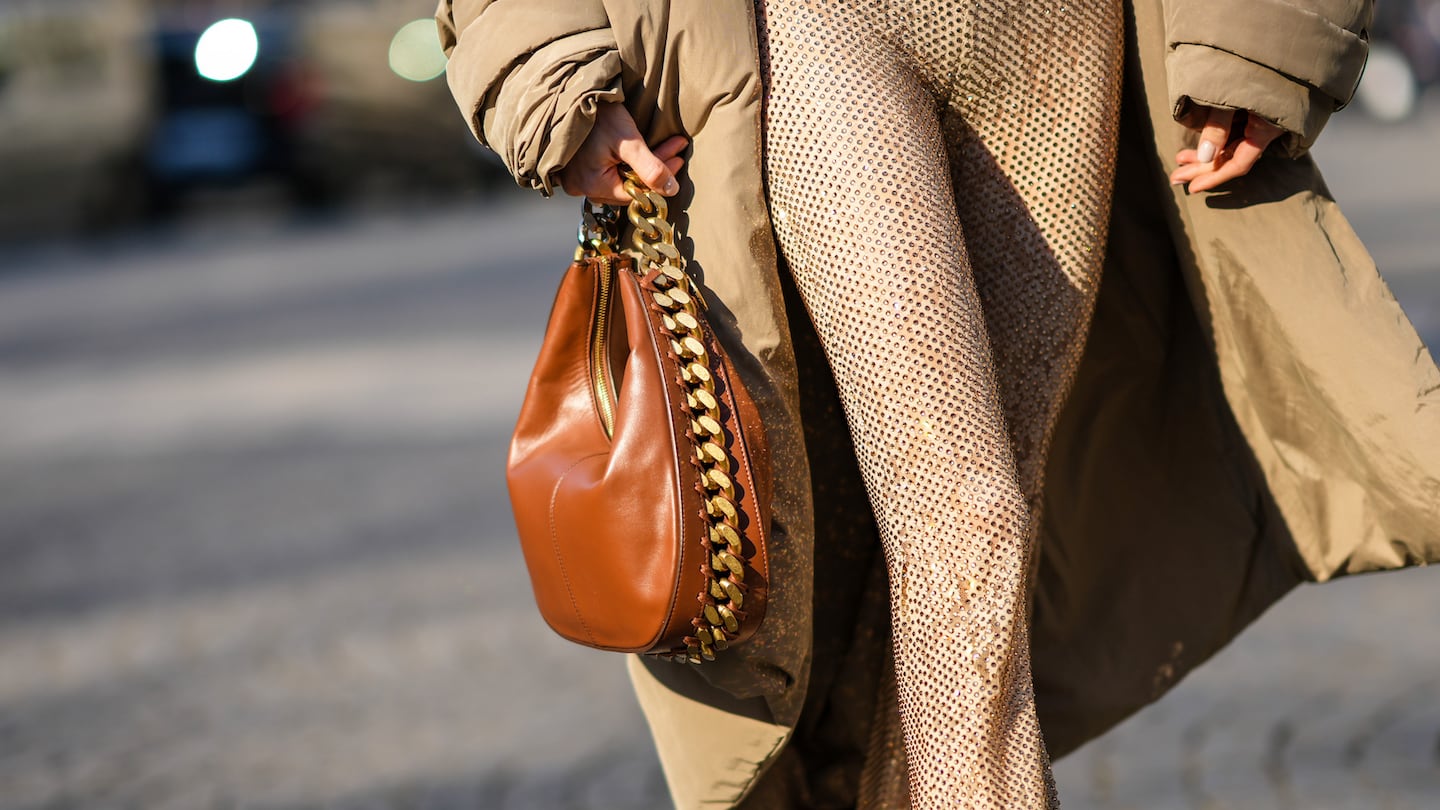
The Business of Fashion
Agenda-setting intelligence, analysis and advice for the global fashion community.

Agenda-setting intelligence, analysis and advice for the global fashion community.

“Do you know where your clothes come from? Would you wear plastic?” Those are questions Australian wool group Woolmark poses as part of its latest campaign.
Launched last week, it features a strikingly haunting video of an oil-slicked trio scrambling from a pool filled with crude against apocalyptically overcast skies. As they emerge, they strip off their tar-drenched garments in favour of wool and the surroundings transform into a natural paradise. The campaign’s tagline: “wear wool, not fossil fuel.”
The choice is “a false narrative,” said filmmaker Rebecca Cappelli, whose documentary “Slay” launched a few days after the Woolmark campaign and highlights the negative impact of animal skins in fashion. “It’s kind of textbook, something you see across the fur, leather and wool industry to attack synthetic fibres … that doesn’t make what they are promoting magically good and ethical.”
Claiming the moral high ground is increasingly important for brands and their suppliers, as sustainable fashion — once the niche domain of only the crunchiest consumers — becomes big business.
ADVERTISEMENT
It’s more than just marketing at stake; brands from H&M to Gucci have made high-profile commitments to avoid materials that don’t meet baseline environmental and ethical standards in the coming years. And regulators are stepping in with policies that fortify those ambitions as more than simply voluntary goals.
But the industry has no standardised way to measure sustainability, or even a clear definition of what “sustainable” means. That’s opened a branding battle that stretches from diamonds to leather, as upstart materials vie with established players to present themselves as the best option for conscious consumers.
“You can’t really finish a sentence these days without the word ‘sustainability’ being in it,” said Woolmark chief executive John Roberts. “Whilst I don’t think we’ve come to any serious agreement on what that means, we know we need to state our case.”
In 2017, Gucci chief executive Marco Bizzarri declared fur passé. Five years later, a material that once embodied the idea of opulent glamour is widely seen as out-of-step with modern luxury.
The shift in attitudes was underpinned by decades of campaigning by animal-rights activists, but once anti-fur sentiment became mainstream, the material’s disappearance from the shelves of many of fashion’s biggest luxury brands and retailers was swift.
Now those shifting cultural currents are challenging even fashion’s most entrenched materials.
Take leather, a profit engine for the luxury sector, prized for millennia for its versatility, durability and cultural value. In 2020, leather goods made up around half of the roughly $100 billion Europe’s five largest luxury companies generated in sales, according to equity analysts at Bernstein.
But the leather supply chain is also linked to animal cruelty, high-impact industrial cattle farming and polluting tanning processes. Alternatives once dismissed as tacky plastic derivatives have been rebranded as luxurious and fashionable vegan materials by labels like Stella McCartney. Associated sectors like plant-based meats and milk have grown rapidly, fuelled by demand from young consumers concerned about both animal rights and the climate crisis.
ADVERTISEMENT
Luxury’s biggest players from Kering to Hermès are dabbling in buzzy leather alternatives derived from mushrooms or grown in a lab. Last year, Danish label Ganni said it would stop using virgin leather by 2023, after finding the material accounted for the bulk of its emissions. Demand for vegan leather products nearly tripled last year, according to fashion search engine Lyst.
“It has become a battleground,” said Debbie Burton, chair of trade association Leather Naturally. In June, the organisation launched a global campaign called “Leather Truthfully,” geared towards addressing common criticisms of the material. It emphasises leather’s versatility and durability, positioning the material as a natural byproduct of the meat industry and underscoring that many alternatives on the market contain substantial amounts of plastic.
Woolmark has taken a similar position with its new campaign. Its current spending on promoting wool’s sustainability credentials is in the “low millions,” CEO Roberts said. “But we know we’re going to do a lot more; it’s gone from zero to hero,” he added.
Animal rights campaigners contest this presentation of materials like leather and wool. Leather itself is often coated in plastic and the role of hides in the economics of the meat industry is murky. Investment in challenger materials is growing too, with ongoing efforts to drive down plastic content and improve performance. The nascent wholesale market for innovative alternatives for animal skins is expected to hit $2.2 billion by 2026, according to nonprofit Material Innovation Initiative.
The problem for consumers is that they are now faced with a plethora of competing sustainability claims from materials all pitching themselves as a better option.
The reality is much more complicated than any campaign might suggest.
“When asked what the best material is, the answer is always, ‘it depends’ ... Every material has tradeoffs,” said Beth Jensen, director of climate and impact at Textile Exchange. “We have to, as an industry and as consumers, get away from this idea that there will always be black-and-white answers.’”
Underlying the current marketing battle is a heated debate over how sustainability should be defined and measured. The industry suffers from a yawning data gap, with the quality of information about many materials limited, dated and unfit for purpose, according to critics.
ADVERTISEMENT
Commonly used metrics lack a defined framework, which means users can pick and choose how they use and present data to fit the narrative they want to tell. And environmental assessments don’t measure important areas like social impact or animal welfare.
Efforts led by European policymakers to more tightly regulate sustainability claims have only fuelled controversies around existing data and methodologies, which animal fibre producers say favour synthetic materials. In June, Norway’s consumer watchdog ruled the Higg Index, one of fashion’s most high-profile sustainability rating tools, was misleading when used to back up eco marketing claims.
For consumers who want to be more sustainable, the simplest solution remains to buy less.
“In some ways I find it baffling,” said fashion industry analyst Veronica Bates Kassatly, who has written numerous reports critiquing fashion’s current approach to measuring impact. “If we wanted to reduce impact tomorrow, everyone would buy less clothes and wear them more.”
For more BoF sustainability coverage, sign up now for our Weekly Sustainability Briefing by Sarah Kent.
 Opens in new window
Opens in new windowFor the first time, brands including Stella McCartney, Balenciaga and Hermès are bringing products made of buzzy mushroom-based materials to market, a critical test for whether the next-generation fabrics could one day hit the mainstream.
Fashion is doubling down on ambitious promises to clean up its environmental impact, but bad and misleading data are complicating efforts to build a more sustainable industry.
Around a fifth of the Danish brand’s sales came from handbags, shoes and other leather pieces last year, but it’s on a mission to stop using virgin leather by 2023.

Sarah Kent is Chief Sustainability Correspondent at The Business of Fashion. She is based in London and drives BoF's coverage of critical environmental and labour issues.
Fashion’s biggest sustainable cotton certifier said it found no evidence of non-compliance at farms covered by its standard, but acknowledged weaknesses in its monitoring approach.
As they move to protect their intellectual property, big brands are coming into conflict with a growing class of up-and-coming designers working with refashioned designer gear.
The industry needs to ditch its reliance on fossil-fuel-based materials like polyester in order to meet climate targets, according to a new report from Textile Exchange.
Cotton linked to environmental and human rights abuses in Brazil is leaking into the supply chains of major fashion brands, a new investigation has found, prompting Zara-owner Inditex to send a scathing rebuke to the industry’s biggest sustainable cotton certifier.